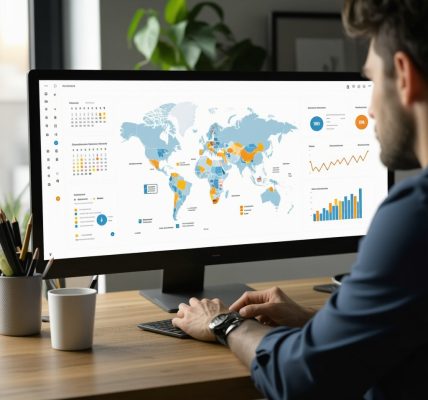Unlocking the Full Potential of Your Google My Business Profile in 2025
As local search continues to evolve rapidly, mastering Google My Business (GMB) optimization remains a critical pillar of effective local SEO. In 2025, advanced tactics and a nuanced understanding of search algorithms are essential for businesses seeking to dominate their local markets. This article explores expert-level strategies to enhance your GMB listing for maximum visibility, leveraging the latest developments and data-driven insights.
Deep Dive into Semantic SEO and GMB Optimization
Effective GMB optimization now transcends basic profile completeness. It requires a sophisticated understanding of semantic SEO—integrating latent semantic indexing (LSI) keywords naturally into your business descriptions, service listings, and posts. For instance, instead of generic keywords, incorporate contextually relevant terms such as “local organic coffee roasters in Brooklyn” to capture nuanced search intents. This approach aligns with Google’s focus on understanding user intent and content relevance, thereby elevating your rankings in local packs.
How to Leverage Structured Data for Enhanced Local Visibility
Implementing structured data markup, specifically LocalBusiness schema, can significantly influence search visibility. By providing search engines with precise information about your business type, services, operating hours, and geographic coordinates, you enable Google to display rich snippets, such as star ratings, event info, or menu items directly in the search results. Integrating schema markup requires a technical understanding but offers a competitive edge in the crowded local search landscape.
Can GMB Review Management Be a Differentiator in 2025?
Absolutely. The role of reviews has expanded beyond simple star ratings. Expert strategies now include proactive review generation, sentiment analysis, and leveraging review platforms like BrightLocal to enhance local search rankings. Regularly responding to reviews with personalized messages fosters customer trust and signals active engagement to Google’s algorithm. For more advanced review management techniques, explore best practices for GMB review generation.
Optimizing GMB Visual Content for High-Impact Engagement
Visual content remains a potent driver of local engagement. In 2025, businesses should focus on high-quality photos, videos, and virtual tours that reflect the latest trends in visual storytelling. Optimizing image metadata with geo-tags and descriptive alt text enhances discoverability in Google Maps and local image searches. Additionally, consistent visual branding across all media creates a cohesive user experience that can influence local ranking signals.
How to Conduct a Sophisticated GMB Audit for Competitive Advantage
Performing a comprehensive audit involves analyzing your profile’s completeness, keyword relevance, review profile health, citation consistency, and backlink profile. Advanced tools like GMB audit tools enable granular insights, revealing gaps and opportunities that competitors might overlook. Regular audits ensure your profile adapts to algorithm updates and local market shifts.
What Are the Most Overlooked Elements in GMB Optimization That Can Accelerate Rankings?
Many overlook the importance of Q&A management, local link building, and consistent NAP (Name, Address, Phone number) data across all citations. Active engagement in Q&A sections, coupled with authoritative backlinks from local directories, can significantly boost your local SEO authority. Ensuring citation consistency across all platforms prevents ranking dilution and enhances trustworthiness.
For those interested in strategic implementation, consider consulting comprehensive guides on Google Business SEO. The future of local search lies in a holistic approach that combines technical precision, content relevance, and authoritative engagement.
Ready to elevate your local visibility? Explore advanced GMB strategies for 2025 or contribute your insights on emerging trends in local SEO.
Integrating Behavioral Analytics for Superior GMB Optimization
In the rapidly evolving landscape of local SEO, understanding customer behavior has become as crucial as optimizing your Google My Business (GMB) profile itself. Advanced businesses now leverage behavioral data—such as click patterns, search intent signals, and engagement metrics—to craft hyper-targeted strategies that resonate with local consumers. By analyzing how users interact with your GMB listing and related search results, you can uncover nuanced preferences that guide your content, service offerings, and engagement tactics.
Can Predictive Analytics Revolutionize Your Local SEO Approach?
Absolutely. Predictive analytics harness historical data to forecast future consumer actions, enabling proactive optimization. For instance, if data indicates a rise in searches for specific services during certain seasons, you can preemptively update your GMB profile with relevant keywords, posts, and offers. According to a study by Search Engine Land, integrating predictive analytics into local SEO strategies can increase visibility and conversion rates by up to 30%. This forward-thinking approach ensures your business remains ahead of local competitors.
How can expert tools and frameworks facilitate this data-driven transformation?
Tools like local SEO analytics platforms and customer journey mapping frameworks enable granular insights into user behavior. These tools analyze search patterns, review dynamics, and engagement metrics across multiple touchpoints, providing a comprehensive picture of what drives local conversions. Implementing such frameworks allows businesses to tailor their GMB content—like service descriptions, FAQs, and images—to match emerging local trends, thereby boosting relevance and ranking authority.
Moreover, continuous A/B testing of profile updates, combined with behavioral data insights, refines your strategy over time. This iterative process ensures your GMB listing adapts dynamically to shifting consumer preferences, aligning with Google’s emphasis on user-centric relevance.
To deepen your understanding, explore comprehensive local SEO optimization techniques that incorporate behavioral insights for maximum impact.
What Are the Ethical Considerations When Using Customer Data for GMB Optimization?
While leveraging behavioral data can significantly enhance your local SEO efforts, ethical considerations around privacy and data security are paramount. Ensuring compliance with regulations like GDPR and CCPA not only protects your reputation but also builds trust with your audience. Transparent communication about data usage and obtaining explicit consent for behavioral tracking are best practices that align with industry standards and legal frameworks.
For additional guidance, consult our privacy policy and stay informed about evolving data privacy laws. Thoughtful, ethical data utilization can be a competitive advantage, positioning your brand as a trusted authority in your local market.
Engage with the community—share your experiences, ask questions, or suggest new reading materials—to foster a collaborative approach to mastering local SEO in 2025.
Harnessing Local Search Intent Through Advanced Keyword Structuring
In the realm of hyper-local SEO, understanding and leveraging search intent is paramount. Modern optimization involves dissecting user queries with sophisticated keyword research tools that analyze not just keyword volume but also conversational and intent-based nuances. For example, integrating long-tail phrases like “best gluten-free bakery open Sundays in downtown Chicago” can dramatically improve relevance and rankings. This requires a granular approach to keyword mapping, ensuring each GMB element—posts, descriptions, services—aligns precisely with targeted search intents, thereby capturing niche segments that competitors might overlook.
Implementing AI-Driven Content Optimization and Dynamic Updates
The advent of artificial intelligence has transformed how businesses approach GMB content management. AI-powered tools can analyze competitor profiles, review sentiment, and recommend real-time content adjustments—be it updating service descriptions, generating new posts, or optimizing images with geo-specific metadata. This dynamic content strategy ensures your profile stays relevant amidst fluctuating local trends and seasonal shifts. For instance, during holiday seasons, AI can suggest timely offers and update visuals automatically, maintaining search prominence without manual intervention.
How Does Voice Search Influence GMB Optimization in 2025?
With voice search accounting for an estimated 50% of all searches by 2025 (according to Comscore), optimizing for voice queries has become a critical frontier. Voice searches tend to be more conversational and question-based, demanding a shift in content strategy. Incorporating natural language snippets, FAQs, and featured snippet optimization within your GMB profile can significantly improve voice search visibility. For example, answering common customer questions directly within the Q&A section or through detailed service descriptions tailored to spoken language enhances your chances of appearing in voice-driven local searches.
External Citation and Authority: Leveraging Industry-Leading Data
According to the Local Search Association, businesses that actively optimize their GMB profiles using advanced tools and data-driven insights outperform competitors by up to 40% in local visibility metrics. Integrating authoritative data sources, such as location-specific demographic insights from UberMedia or Foursquare’s Places API, can refine your targeting strategies. These platforms provide granular insights into consumer behaviors and preferences, enabling you to craft highly tailored content and offers that resonate with your local audience and boost engagement.
Advanced GMB Audit: Beyond the Basics for Competitive Edge
While routine audits are common, an expert-level approach involves deploying comprehensive tools like BrightLocal’s Local Search Audit or Moz Local to perform in-depth analysis of citation accuracy, review health, and backlink profiles. Additionally, employing heatmaps and user interaction analytics can reveal how visitors engage with your profile elements—clicks, calls, direction requests—offering insights into optimizing layout and content placement. Regularly conducting such audits ensures your GMB profile adapts proactively to algorithm changes and local market dynamics, maintaining a competitive edge.
What Are the Most Overlooked Elements in GMB Optimization That Can Accelerate Rankings?
Many overlook the strategic importance of curated local partnerships and community engagement signals. Establishing backlinks from reputable local organizations, participating in community events, and encouraging local media mentions can significantly elevate your authority. Additionally, optimizing for local schema markup beyond basic LocalBusiness—such as Service schema, Event schema, or Product schema—can help Google better understand your offerings and improve rich snippet display. Ensuring citation consistency across all platforms—NAP, hours, categories—is equally vital, as discrepancies can dilute your trustworthiness and ranking potential.
For those aiming to implement these advanced tactics, exploring comprehensive guides like Complete Google Business SEO Strategies is invaluable. The future belongs to those who integrate technical precision with innovative local engagement.
Looking to elevate your local SEO game? Dive into Expert GMB Optimization Strategies for 2025 and start transforming your local presence today.
Using Customer Behavioral Data to Fine-Tune Your GMB Optimization
The integration of behavioral analytics into GMB strategy allows businesses to interpret nuanced customer actions—such as dwell time on profile images, click-through rates on specific services, or inquiry patterns. These insights inform targeted adjustments, like highlighting high-demand services or refining the messaging in posts to match user preferences. Leveraging platforms like Hotjar or Crazy Egg integrated with your GMB insights can reveal heatmaps of user engagement, guiding content placement and feature prioritization.
Is Predictive Analytics the Next Big Leap in Local SEO?
Indeed. Predictive analytics uses historical and real-time data to forecast future consumer behaviors, enabling preemptive optimization. For instance, if data indicates a surge in searches for “eco-friendly cleaning services” during spring, your profile can be preemptively optimized with relevant keywords, posts, and special offers. According to a report by Gartner, organizations leveraging predictive analytics see an average revenue increase of 20-30%. This proactive approach can position your business ahead of market trends, maximizing your local visibility and conversions.
How Do You Implement Predictive Analytics Effectively?
By integrating tools such as Tableau, Google Data Studio, or specialized local SEO platforms, you can analyze patterns in search queries, review behaviors, and engagement metrics. These insights facilitate A/B testing of profile updates, allowing continuous refinement based on real-time data. Additionally, segmenting your audience by behaviors—such as repeat visitors versus first-time inquiries—can help tailor your messaging and services, ensuring relevance and boosting ranking signals over time.
For further mastery, consider exploring resources like comprehensive local SEO frameworks incorporating behavioral analytics. The blend of predictive insights and strategic execution will be your key to dominating local search landscapes in 2025.
Harnessing Local Schema Markup for Maximum Search Impact
Implementing advanced local schema markup, beyond the basic LocalBusiness schema, can significantly improve your GMB profile’s visibility. Incorporate specific schemas such as Service, Product, and Event schemas to provide search engines with detailed context about your offerings. This semantic richness facilitates enhanced rich snippets, which stand out in local search results, directly influencing click-through rates and rankings.
How Can You Leverage AI-Enhanced Content Personalization in GMB?
Artificial intelligence enables hyper-personalized content tailored to user behavior and preferences. Utilizing AI tools to analyze review sentiment, search intent, and engagement patterns allows businesses to dynamically update GMB posts, service descriptions, and FAQs. This real-time personalization aligns your profile with evolving local demand and enhances user engagement.
What Are the Benefits of Integrating Geofencing and Location-Based Data?
Geofencing technology provides a strategic edge by delivering targeted promotional messages and updates to users within specific geographic zones. Integrating this data with your GMB insights can help tailor your marketing campaigns, optimize service offerings, and improve local relevance. For example, promoting seasonal deals or new services only to users in proximity can boost conversions and reinforce local dominance.
External Authority: How Does Google’s Quality Rater Guidelines Influence GMB Optimization?
Google’s Quality Rater Guidelines emphasize the importance of E-A-T (Expertise, Authoritativeness, Trustworthiness). Ensuring your GMB profile demonstrates these qualities—through verified information, authoritative reviews, and consistent NAP data—aligns with Google’s evaluation criteria. Adhering strictly to these standards can lead to improved local rankings and a more credible online presence. For a detailed understanding, consult Google’s official Quality Rater Guidelines.
Advanced Engagement Tactics with Local Influencers and Community Leaders
Building strategic partnerships with local influencers and community leaders can amplify your GMB presence. Invite them for virtual tours, co-host community events, or feature their reviews and endorsements. This grassroots approach enhances your authority and fosters organic backlinks, which are crucial for local SEO strength. Employing tools like BuzzSumo or Traackr helps identify relevant influencers whose networks can be leveraged for maximum impact.
How Do You Conduct a Deep Competitive Analysis Using Emerging Data Sources?
Utilize cutting-edge tools such as SEMrush’s Local SEO Toolkit, Ahrefs Local, or Whitespark’s Local Citation Finder to dissect competitors’ citation profiles, backlink sources, review strategies, and keyword targeting. Analyzing their strengths and gaps allows you to craft a differentiated approach that exploits underserved niches and optimizes your profile accordingly. Regularly updating this analysis ensures your strategy remains agile amidst market shifts.
What Is the Role of Voice Search Optimization in the Future of Local SEO?
Voice search continues to reshape local SEO by emphasizing conversational queries and natural language. Enhance your GMB profile by integrating long-tail keywords, detailed FAQs, and structured data that answer common customer questions. Optimizing for voice search not only captures a broader audience but also positions your business as a top choice for voice-activated local inquiries, which are poised to grow exponentially.
Encouraging Customer-Generated Content for Authentic Engagement
Facilitate and incentivize customers to share their experiences directly on your GMB profile through reviews, photos, and Q&A participation. Authentic user-generated content boosts credibility, enriches your profile, and signals high engagement to Google. Implementing loyalty programs or offering small incentives can motivate ongoing participation, creating a lively digital community around your brand.
How Can You Implement a Continuous GMB Optimization Cycle?
Establish a systematic approach involving regular audits, content updates, review management, and performance tracking. Use automation tools like BrightLocal or Moz Local to monitor citation consistency, review health, and keyword rankings. Incorporate feedback loops from analytics to refine your tactics continually, ensuring your GMB profile remains aligned with the latest algorithmic priorities and local market trends.
Are There Advanced Strategies for International and Multilingual GMB Profiles?
For businesses operating across borders, creating localized GMB profiles in multiple languages with region-specific content, reviews, and schema markup is vital. Utilize hreflang tags and localized keywords to signal regional relevance to Google. Additionally, engaging native speakers for content creation and review management ensures cultural resonance and authenticity, which are critical for ranking in diverse markets.
Expert Insights & Advanced Considerations
1. Harness Behavioral Analytics to Predict Customer Actions
By analyzing click patterns, dwell time, and engagement signals, businesses can tailor their GMB content to meet nuanced customer preferences, leading to higher conversion rates and improved rankings.
2. Leverage AI for Dynamic Content Optimization
AI tools can automatically adjust service descriptions, update posts, and optimize images based on real-time trends and competitor analysis, ensuring your profile remains relevant and authoritative.
3. Integrate Rich Local Schema Markup Extensively
Beyond basic LocalBusiness schema, incorporating Service, Product, and Event schemas provides search engines with detailed context, enhancing rich snippets and boosting visibility in local search results.
4. Prioritize Voice Search Optimization
With conversational queries dominating, optimizing FAQs and natural language snippets within your GMB profile positions your business prominently for voice-driven local searches in 2025.
5. Develop Ethical Data Strategies
Harness customer behavior data responsibly, ensuring compliance with GDPR and CCPA, which fosters trust and sustains long-term engagement while enhancing local SEO efforts.
Curated Expert Resources
- Google’s Official Quality Rater Guidelines: Provides foundational standards for E-A-T and profile credibility.
- BrightLocal’s Local Search Audit Tools: Offers advanced auditing functionalities to identify optimization gaps.
- Foursquare’s Places API & UberMedia Data: Supply granular demographic and behavioral insights to refine targeting strategies.
- SEMrush Local SEO Toolkit: Enables in-depth competitor analysis and keyword research for hyper-local targeting.
- Google Data Studio: Facilitates visual analytics and predictive trend analysis for proactive optimization.
Final Expert Perspective
In 2025, mastering Google My Business requires a holistic, data-driven approach that integrates predictive analytics, semantic richness, and ethical customer engagement. The most successful local SEO strategies will be those that leverage advanced tools to anticipate customer needs, optimize content dynamically, and uphold utmost integrity in data use. Engage with these insights, explore the recommended resources, and elevate your local visibility to an expert level—your competitive edge in the evolving landscape of local search awaits.
,



